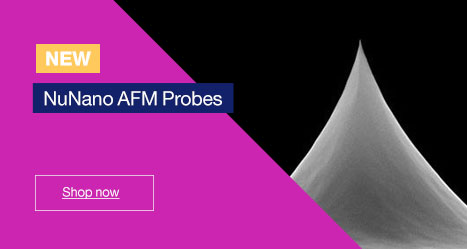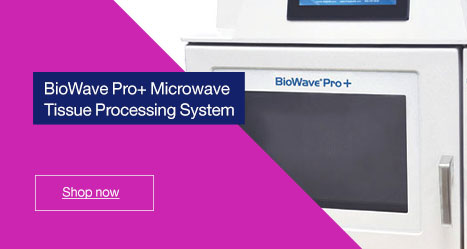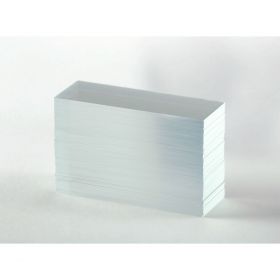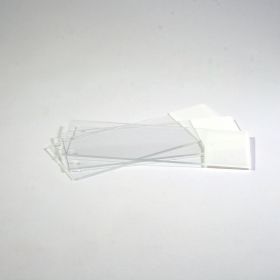Although we very briefly touched on slide coating in a previous article, I wanted to describe in more detail the many ways in which slides and coverslips are prepared for different purposes including growing cells on them and helping sections to stick to them through the process of immunohistochemistry (IHC).
In this article, we will look at cleaning and rinsing of slides/coverslips, sterilising slides/coverslips for growing cells and different methods of coating slides/coverslips. There is no single correct way to prepare slides or coverslips and it will depend on factors such as the cell-line being used.
Cleaning slides and coverslips
Although many slides are supplied as pre-washed (such as these ones https://www.agarscientific.com/lm/slides-coverslips/microscope-slides), many labs and scientists still prefer to wash their own slides/coverslips and it is obviously more important to do so if using items from a packet which is already open. A freshly opened box may look clean, but there may be a thin film of grease from the manufacturing process which will prevent optimal adherence of cells.
- Washing with PBS/water
Although many protocols advocate washing in water or PBS before use, such washing may not get rid of any oil/grease based films from the surface of the glass and the addition of PBS may in fact leave salt crystals on the surface when it dries.
- Acid washing of coverslips is recommended particularly if you are planning to grow adherent cells on the surface and it helps polypeptides to adhere to the glass. It is a relatively long protocol though, so it is best to plan in advance and make up a batch of acid-washed coverslips and store them in a clean container.
- Separate the coverslips and incubate them in 1M HCl at 500C to 600C for between four and 16 hours.
- Allow the HCl to cool to room temperature and then rinse two times in double-distilled or ultrapure water.
- Add double-distilled or ultrapure water to the coverslips and sonicate for 30 minutes. Repeat this twice using fresh water each time.
- Sonicate the coverslips for 30 minutes in a solution of 50% ethanol (make up all the ethanol solutions with double-distilled or ultrapure water).
- Sonicate the coverslips for 30 minutes in a solution of 70% ethanol.
- Sonicate the coverslips for 30 minutes in a solution of 95% ethanol.
- Remove the final ethanol wash and store the coverslips in 95% ethanol until use.
A slightly shortened version of this protocol involves taking the coverslips from step (3) above, rinsing them in 100% ethanol, drying and storing them in a clean airtight container until use. Other similar methods involve the use of commercial glass cleaners in place of the hydrochloric acid.
Sterilising coverslips
- Ethanol
Most protocols for sterilising coverslips advocate the use of ethanol in concentrations ranging from 70% to 100%, either with or without further sterilisation steps.
If using ethanol alone, the coverslips can be placed in the bottom of a sterile 6-, 12- or 24- well plate and covered with 70% ethanol, left for five minutes and repeated three times. Follow this with a final wash in 100% ethanol.
A more thorough method (and more time consuming) is to dip a coverslip in 70% ethanol and flame with the blue flame of a Bunsen burner. There’s an obvious hazard here though- keep the ethanol stock well away from the flame! Flaming will eliminate most micro-organisms and spores from the surface of the glass.
- UV LightUV light is often used in conjunction with 70% ethanol. Dip the coverslips in 70% ethanol and then expose to the UV light in a tissue culture hood for between 20 and 30 minutes. Alternatively, UV exposure can be used on its own.
- Autoclaving
This is one of the easiest methods to sterilise coverslips. Simply place the coverslips in a glass petri dish and send through the dry cycle of an autoclave. This is typically a 20 minute step. Some protocols advocate a 70% ethanol wash beforehand, but autoclaving alone will ensure that the glass is tissue culture sterile. Just remember to open the petri dish in a tissue culture hood and use sterile forceps to remove each one.
Coating slides and coverslips
As with cleaning and sterilising, there are many methods for the coating (or ‘subbing’) of slides and coverslips. The coatings used depend largely on the cells which you wish to grow on the glass. The most common coating is poly-lysine, but we will also take a look at collagen, laminin and fibronection.
- Poly-Lysine
Poly-Lysine enhances the electrostatic interaction between the positively charged ions on the surface of the glass and the negatively charged attachment ions of the cell membrane. Poly-Lysine not only increases the electrostatic bond between cells and the glass surface, but also helps to ensure that frozen and paraffin embedded sections remain stuck to slides during the many IHC steps.
Two types of poly-lysine are available and the choice will depend on the cells type you are using. Poly-L-lysine is the most commonly used and is also suitable for tissue sections. However, some cell lines can excrete proteases which break down Poly-L-lysine, so it is recommended to use Poly-D-lysine instead.
Poly-L-lysine has been shown to be a suitable coating for cells such as primary neurons, neuronal cell lines, PC12 cells and HEK293 cells. As with many of these cleaning and coating methods, there are a variety of options, but below is a standard method for poly-lysine coating;
- Clean the slides/coverslips before coating. If you are coating coverslips to grow cells on, then it is recommended to acid-wash these beforehand.
- Make a 1 mg/ml poly-lysine solution in sterile water. If coating coverslips, place these in a sterile plastic petri dish and cover with poly-lysine solution. If coating slides, place in a clean slide rack in a dish and again, cover with poly-lysine solution. The optimum ratio of poly-lysine solution to glass surface is 1 ml: 25 cm2 (this works out around 900 slides/litre of solution).
- Place slides or coverslips on a rocker and rock gently for 5 minutes at room temperature.
- For coverslips, remove solution by aspiration and wash with sterile water. Allow to dry for at least 2 hours before use. For slides, pour off poly-lysine and dry in a 600C slide oven for an hour.
- Coated glass can be stored at 40C in a sterile container for up to three months.
Pre-coated poly-lysine slides are also commercially available, such as these ones from Agar Scientific;
https://www.agarscientific.com/lm/slides-coverslips/polysine-microscope-slides
- Collagen
Collagen is an extracellular matrix protein which can be used on coverslips to promote adherence of cells such as epithelial and endothelial cells as well as cells lines such as CHO and HEK293 cells. The most commonly used collagen is type I (isolated from rat tails). Other types used for adherence include type II and type IV, but also use the recommended type depending on the cells you wish to grow on the coverslips.
- Fibronectin
Fibronectin is also an extracellular matrix protein which contains an RGD sequence (Arg-Gly-Asp) which mediates cell attachment. For this matrix protein, the species source is unimportant as all contain the RGD sequence. Many cell types will attach to fibronectin coated glass including endothelial cells, fibroblasts, neuronal cells, and CHO and HEK293 cell lines.
- Laminin
Laminin is an extracellular matrix protein and is a major component of one of the layers of the basement membrane. Laminins bind to cell membranes through integrin receptors and other plasma membrane molecules. Laminins are a suitable coating and substrate for a wide variety of cell types ranging from fibroblasts to neuronal cells. Some protocols advocate pre-coating of slides/coverslips with poly-lysine before laminin coating for extra adherence.
AUTHOR: MARTIN WILSON




